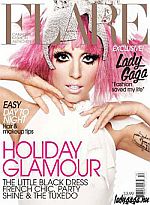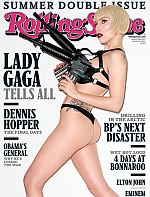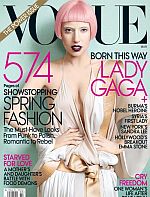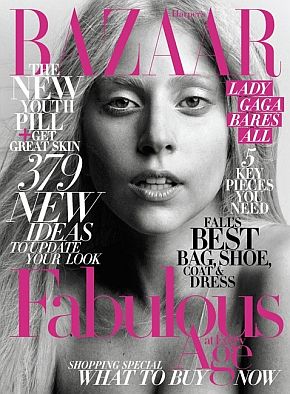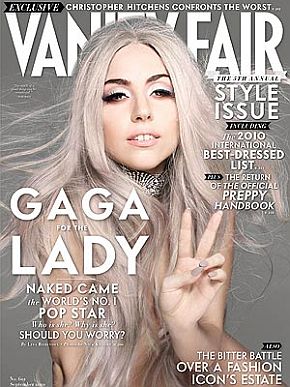In May 2011, an upbeat and energetic Google TV ad starring pop music phenom Lady Gaga began running on mainstream TV channels, drawing lots of attention and praise. In the ad, Gaga and her fans are featured in what is essentially a 90-second music video that uses her upbeat song, “The Edge of Glory,” as its soundtrack. But the ad, which is quite well done, also provides a window on the technology powerhouse that is Google and how that company is changing — both in terms of its public image and how it may use its powers in the future. More on that part of the story a bit later. First, the video, and following that, a more detailed look at the ad, isolating some of its screenshots below to provide a somewhat “slower” look at its elements and composition.
The Google Ad
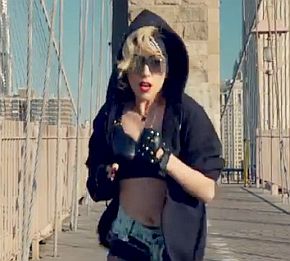 Lady Gaga jogging on the Brooklyn Bridge, Google ad. |
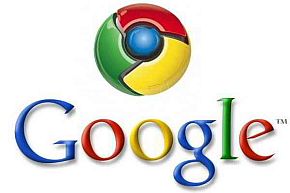 Google’s logo for its “Chrome” internet browser. |
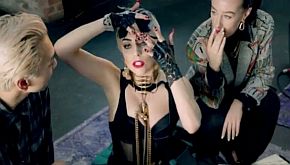 Lady Gaga attending to decorative details. |
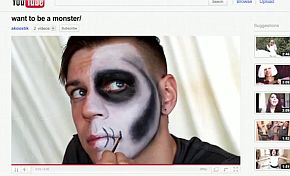 This fan-submitted video on YouTube titled “want to be a monster,” appears in the Gaga-Google ad. |
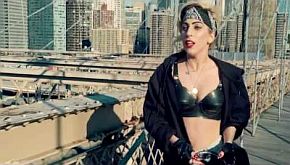 Shots of Lady Gaga on the Brooklyn Bridge are interspersed with fan videos in Google’s Chrome ad. |
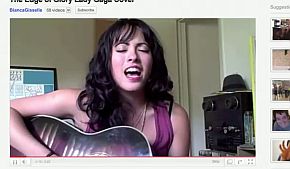 Another fan-submitted YouTube video covering Gaga’s song in the Google Chrome TV ad. |
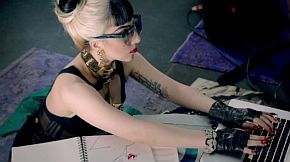 Lady Gaga sends internet messages in Google TV ad. |
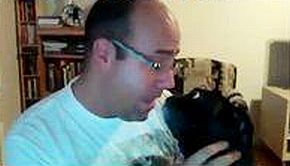 Lady Gaga fan in the Google ad singing to his dog. |
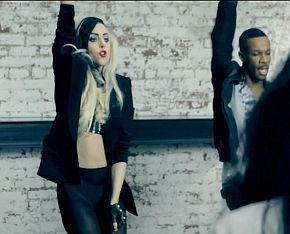 Lady Gaga dancing with others in Google ad. |
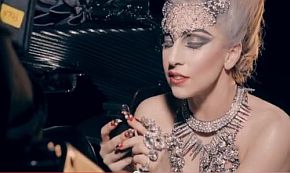 Lady Gaga appears to be scrolling on hand-held device in this screenshot from Google’s Chrome ad. |
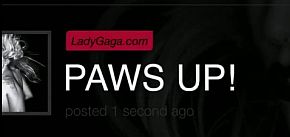 Lady Gaga sends encouragement to her fans. |
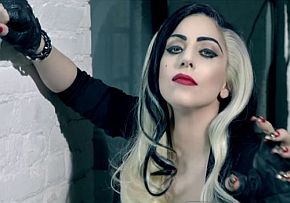 Lady Gaga in her own “paws up” pose. |
 Gaga continues her workout on the Brooklyn Bridge. |
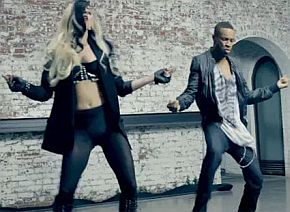 Gaga and black guy dancing in Google ad. |
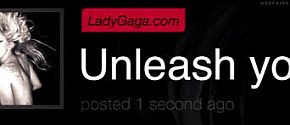 Gaga message: "Unleash your inner monster!" |
 Gaga in pensive moment in Google Chrome ad. |
 Guy in Google ad showing off Gaga-like costume. |
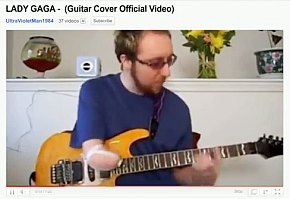 Handicapped guitarist playing Gaga cover song. |
 Lady Gaga in closing frames of Google ad. |
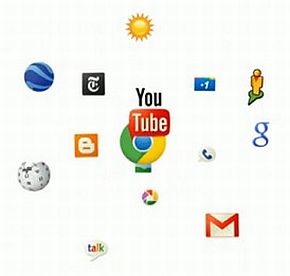 In the final frames of the ad, clicking on the Chrome icon yields a display of other Google icons, each representing other web possibilities. |
Ostensibly, this TV commercial — which was also posted as a YouTube video – is an advertisement for Google’s “Chrome” internet browser. For those who may not know, a browser is a piece of software that enables internet users to do many wondrous and varied things on the web, from viewing websites to sharing videos and more. Other companies — Google competitors — also offer browsers, such as Microsoft’s “Explorer” or Mozilla’s “Firefox.” Interestingly, however, in market research Google discovered that many people had no idea of what a browser was, nor did they realize they had a choice of browsers and could download a different browser than those pre-loaded on phones, laptops and PCs.
Google’s Lady Gaga ad, however, is more than just a marketing pitch for the Chrome browser; it’s actually more like a celebration of the internet and its many powerful possibilities, casting Google and its tools in a very positive light. Not least, of course, is that Google also wins the implied endorsement of Lady Gaga — and as Google is hoping, millions of her fans as well. Google also gets a share of brand-name affirmation here. But the ad, in any case, is quite entertaining and captivating, even for those who see it by accident – and even for those not knowing a thing about Google, Chrome, Lady Gaga, browsers, or the internet.
Lady Gaga, of course, is the star of this commercial and, in a showcase of web interactivity, so are her fans, whom she affectionately calls “Little Monsters.”
The ad opens with a shot of Google’s Chrome logo, and then moves to a frame showing a message from Lady Gaga being typed into the Chrome browser with the title, “listen up, little monsters!” The scene then cuts to Lady Gaga jogging on New York’s Brooklyn Bridge with Manhattan in the background. Gaga is attired in a black leather bra and shorts with black hoodie, looking a bit like a female version of Rocky Balboa. The camera cuts back and forth between Gaga’s workout on the bridge and her fans’ videos several times during the ad.
For some viewers, and even her ardent fans, Lady Gaga has not often been seen apart from her stage acts or other highly-managed public appearances where she is typically dressed in some exotic new costume and engaged in an extravagant music production. And non-fans may only know her from magazine covers or TV appearances. So to see the pop star cast as an average person jogging in the real world may provide a new perspective.
Back in the video, Gaga is shown in one frame with two assistants in a dressing area as the scene cuts quickly through a series of fan-generated YouTube videos – a guy doing “monster”-like facial makeup; a female fan with guitar singing the Gaga tune; a black guy in a stairwell singing; a couple of kids dancing in their bedroom, and more. A fan in a white wig appears next doing an acoustic ukulele cover of Gaga’s song, followed by other imitators, prompting a Gaga typed-in message, “You are ALL beautiful.”
Then come more dance scenes from fans on YouTube – a couple of kids in their bedroom, a guy in his kitchen, a middle-age lady outside her home, and a fan holding up a Gaga’s CD, Born This Way. A Gaga query on YouTube follows, yielding more video clips, including one guy who looks to be in his 30s singing the Gaga tune to a little black dog he is holding. Gaga clicks on several more choices to view them, then types, “You’re all superstars. You inspire me!”
More frames whiz by; one with a girl dancing with abandon as her father scoots by to one side, not sure of what he’s seeing. Then comes a quick shot of Gaga and a black guy dancing, then Gaga alone, boxer style, jumping side-to-side with feet together, all in sync with the music.
A few frames later Gaga appears to be sitting alone or riding in car viewing a hand-held device of some kind, presumably surfing the web or reading her mail. Then comes the message, “PAWS UP!,” followed by fans showing their best “claw pose,” then Gaga doing the same in a deadpan pose.
Back on the Brooklyn Bridge briefly, Gaga is seen doing some footwork, Manhattan behind her in a bright blue-sky day as the music beats away. More fan videos follow – among them, the “Lady Gaga Dance Squad” in a mirrored studio, followed by a young guy on a rooftop smiling and making his best Gaga-like dance moves; then cut to Gaga again, in her hoodie, dancing side-by-side with a black guy. Another typed message to fans: “Unleash your inner monster!”
Then come more YouTube videos of dancing Gaga fans, including one couple who appear to be performing on an inside window sill with some abandon; a guy alone in a hallway shaking his butt in sync with the music; Gaga back on the bridge putting down a few wild steps; then another Gaga message – “this is our moment” – followed by Gaga in a quiet, pensive cool-down moment back on the bridge looking out over the city.
More scenes follow of Gaga’s dancing inter-cut with fan videos, including a guy twirling around with a giant floral decoration on his shoulder, and another of a handicapped young man performing a Gaga song on an electric guitar with a prosthetic aid. Then cut to Gaga in a salmon-beige-colored dress who appears to be performing somewhere, followed by a YouTube fan video from a teenage boy titled, “Gaga Wear” — i.e, Gaga-inspired “clothing” he made — part of which appears to be a cork-type facial decoration this kid wears across his eyes, along with a wavy red-ribbon material as a shirt.
Then back to Gaga on the Brooklyn Bridge, dance-running and skipping, followed by a scene of about 30 young elementary school kids in a studio room dancing and jumping to the song and then a shot of a teenage girl in a YouTube video twirling around in her bedroom alone amid falling confetti.
A screenshot of Gaga’s sign-off message appears: “Stay Strong Little Monsters!” Close-up shots of Gaga back on the bridge follow, her face filing the screen, one of her throwing a kiss to fans Dinah-Shore style, and another, smiling.
A final sequence of frames then appears, one with the words, “Lady Gaga, Mother Monster,” followed by another that reads, “The web is what you make of it.” Then there’s a click sound as the cursor hits the Chrome logo, sending out a little explosion of other Google icons in a concentric array around the Chrome icon, each representing other Google tools and/or web possibilities.
The 90 seconds in this ad race by quickly, but on the whole the ad leaves the viewer feeling pretty buoyant and upbeat, if only for the music and the energy of all those dancing fans.
Google’s Message
The Google ad, however, has multiple purposes, the most important of which is to show Google products as web enablers – whether search, e-mail, video posting, blogging, and more. Each frame has Gaga or her fans making use of a Google product, whether it’s the Chrome browser, Google search, G-mail, or YouTube. Gaga is shown as an artist who relies on the web and how she uses it to communicate directly with her fans around the world, building one of the world largest fan bases in the process. As Google itself has explained of this ad:
“This film celebrates Lady Gaga’s special and unmediated relationship with her fans, the Little Monsters. The making of this film is a demonstration of the power of the web in its own right. The entire project, beginning with Lady Gaga’s shoot in NYC on May 8th [2011], to shipping materials to the television networks for air, took 10 days. Within hours of the release of her new single “Edge of Glory” on May 9th, fans began uploading videos on YouTube, making the song their own by dancing to it, singing it and playing it on all kinds of instruments. Lady Gaga then posted a message on her website asking for more videos to be used in the film project. Fans responded within minutes and uploaded hundreds more videos. Back in the editing room, in real time as fan videos streamed in, editors were putting them into the film. The film was completed on May 18th in time to air during Lady Gaga’s performance on the season finale of Saturday Night Live, and to also live on the web.”
Gaga’s guest appearance on NBC’s Saturday Night Live that evening helped pull in millions of viewers who also saw the Google ad premiere. With Justin Timberlake hosting and Lady Gaga as the musical guest, SNL garnered its highest ratings for a season finale in seven years. Nielsen reported that the show averaged a 7.0 rating in major local markets — meaning about 7 percent of homes with televisions watched the episode — up from a 5.8 rating for the same episode the previous year. And Lady Gaga did her part that night as well, alerting her followers via Twitter that there was something special coming that night beyond the show: “To everyone watching TimberGagaSNL tonight, I have a GLORIOUS surprise! Watch the commercial breaks little monsters. This is our moment!” The next night, Sunday May 22nd, the Google ad with Lady Gaga was seen by millions more, as it ran during the 2011 Billboard Music Awards, broadcast live on the ABC television network.
For those not experienced with the web there is a quite a lot going on in this ad that will be missed or not fully understood. But Google is primarily targeting young people with the ad, and specifically the “Lady Gaga market” – i.e, her 10 million-plus loyal fan base. Still, given the quality of this ad, gains beyond the Gaga market have already arrived and more will come. As of October 2010, for example, the YouTube posting of this ad on Google’s Chrome page has received a steadily rising share of visitors, with more than 4.2 million pageviews.
The net effect of the ad appears to be more emotional and impressionistic than it is hard-core marketing – and for Google, that is not a bad thing. All in all, strung together as it is, the ad offers a kind of celebration of human potential. A positive feeling seeps out of it; even dare say a bit of viewer pride on behalf of those portrayed, as each of the clips shows someone with an inspired bit of spontaneity, or otherwise letting loose with their inner creative selves in some form, be that through dance, art or music. And all of that expression is given voice by way of the web and web tools like Google Chrome.
Of course, that’s what good advertising is supposed to do: make us feel something with creative arrangements of sight and sound. Still, kudos to Google and their team for this ad and the others in this series, which is further explored below.
More Human
The Lady Gaga ad, however, is one of a series of ads Google has used since May 2011 to promote its Chrome browser. These ads, like the Gaga ad, are also part statement on Google the brand and part statement on the technology’s potential – even if not the intention. And for Google, this series of ads also took the company into new territory, as they began presenting the company with a much more human face.
Google, it must be remembered, is a geek-born entity and proud of it – no knock there, as their engineering focus has certainly changed the world for the better. Secondly, Google is primarily about selling advertising, not using it. For most of the company’s short existence – founded in 1998 – it had not really seen the need to do major mainstream advertising about itself or its wares. Google grew to fame by that old tried-and-true method, word of mouth. What little advertising the company did was mostly on-line, and not well known beyond that, and certainly not on prime-time television.
“Parisian Love”
Then in early 2010, for the Super Bowl, Google ventured into the more mainline advertising arena with “Parisian Love,” an ad that tells the story of an American exchange student falling in love with a woman in Paris.
This “story,” however, is “told” entirely in 30 seconds using Google’s search page as the sole visual, with a series of typed-in search queries as storyline – e.g., “how to impress a French woman,” “what are Truffles?” “Churches in Paris,” and finally, sometime after the honeymoon, “how to assemble a crib.” The final screenshot says simply: “search on.”
This Google ad uses a spare piano score as background and makes its point about the power and possibilities of search in modern life, but also importantly includes the human element in its storyline. Google’s “Parisian Love” Superbowl ad of 2010 told a love story in 30 seconds using only Google’s search page and a series of typed-in queries as the storyline. It was really Google’s first foray into more mainstream TV advertising, and the forerunner of the ads it launched in May of 2011, including the Lady Gaga Chrome ad.
Google appears to have become more involved with mainstream advertising around 2007 when it hired former Ogilvy advertising executive Andy Berndt to build a new creative unit internally. A year later, the company added Robert Wong, formerly an Arnold advertising director who had also worked at Starbucks. Today, Google’s Creative Lab is a 50-person shop – powered in part by younger creatives whom Google has recruited and is schooling as it goes – that works closely with Google marketing and outside ad agencies such as Bartle Bogle Hegarty ( who worked on the Gaga ad), Cutwater, and Johannes Leonardo, among others. Robert Wong, creative director of the Lab, has stated that among the Lab’s main tasks are: to “remind the world what it is that they love about Google;” to communicate the company’s innovations, intentions and ideals; and to “manage and steward” the brand.
“Dear Sophie”
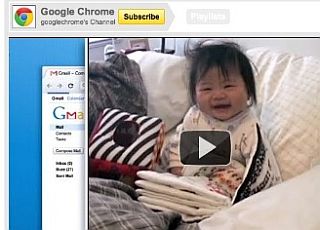
Screenshot from "Dear Sophie" Google Chrome ad.
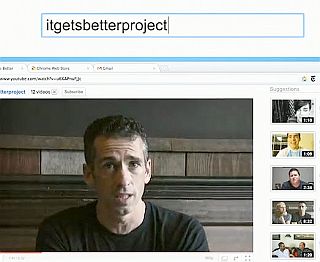
Journalist Dan Savage appeared in a May 2011 Google TV ad about the “It Gets Better Project."
Lady Gaga wanted to be involved with the company that was sending out “It-Gets-Better” messaging.
The ads first aired during the TV shows “One Tree Hill” and “Glee” in early May 2011 on a Tuesday evening. Wrote reviewer Jennifer Bergen from Geek.com: “After watching two commercials from Google advertising its Chrome browser, I’m pretty choked up, and I kind of want to give someone a hug.”
Lady Gaga, in fact, decided to do her Google Chrome ad after she had seen “It Gets Better.” The Google ad team met her backstage after a concert to show her some samples of what they were doing, and according to her manager, Troy Carter, “It Gets Better” had an emotional impact on Gaga. She decided then she wanted to be involved with the company that was making those kinds of statements. And so they teamed up for the ad, which Gaga did for free; that is, Google did not pay her. But Gaga is obviously reaping benefit from the ad, reaching beyond her normal fan base and getting more publicity and exposure in a broader arena. Google’s Creative Lab developed the ad campaign along with ad agency Bartle Bogle Hegarty (BBH).
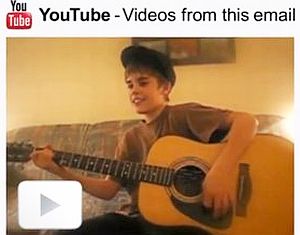
Teen idol Justin Bieber also appeared in a Google TV ad.
Ads like those for Bieber and Gaga are potentially “two-fers” for Google – i.e., gaining ground with a target audience, whether Gaga or Bieber fans, the gay/lesbian community, or some other specific audience. And they also reach a more general mainstream TV audience. Some of the ads also remain on line at YouTube and are often shared and embedded on numerous websites where they continue to be viewed as well.
Google has since made other similar TV ads — one showcasing a young couple in the restaurant business and another using the popular “angry birds” video game as a hook. Yet clearly, Google’s messages using more human themes and emotional content have received popular notice and have taken the company to a new level of public appreciation, consistent in one sense with its guiding moto of “don’t do evil.”
|
“The Edge of Glory” In a May 2011 interview with New York Times writer Jon Pareles, Lady Gaga was asked about her song, “The Edge of Glory,” which is used, in part, in the Google Chrome ad. The exchange between them went as follows: Q: Can you tell me more about “The Edge of Glory”? A: I wrote that song about my grandpa when he passed away, and it means a lot to me. And Clarence Clemons played saxophone, and I listened to him growing up so it represents my youth. The song was about how when my grandma was standing over my grandfather while he was dying, there was this moment where I felt like he had sort of looked at her and reckoned that he had won in life. Like, I’m a champion. We won. Our love made us a winner. They were married 60 years. And then we left and he died. And I thought about that idea, that the glorious moment of your life is when you decide that it’s O.K. to go, you don’t have any more words to say, more business, more mountains to climb. You’re on the cliff, you tip your hat to yourself and you go. That’s what it was for me in that moment when I witnessed it. And then, as I began to write the song, I thought about, you know, living on the edge of your life in a way that when you reach that moment it is glorious. The lyric is it’s hot to feel the rush, to brush the dangerous, being unafraid to fall deeply in love, being unafraid to go out all the way to the brink of your imagination. Q: It has a long, long coda. A: The coda is full-out. It’s so sexy, and it’s like the sax is singing for me, I don’t need to sing, I just need to throw on an emerald green dress and twirl around on a street corner. |
Gaga Ad a Hit
Lady Gaga’s TV ad for Google meanwhile — now on You Tube at four-million plus visitors and climbing — has obviously struck a chord with many of her fans. But it has also reached beyond her fan base, provoking some thoughtful commentary in a few places. For example, author Grant McCracken writing in his blog at the Harvard Business Review observes:
…In part, the Chrome ad is a message from Lady Gaga to her fans… [It ] is an explicit call to arms, asking fans to embrace their otherness, their eccentricity, their most exuberant, expressive selves.
…Kids dancing like maniacs in the kitchen. People find their way out of conventional selves into more vivid ones. Life as a reckless pursuit of the sublime. That is what America is for. Or to use the more solemn language of Daniel Bell, the great American sociologist, this is our expressive individualism, the right of every American to be whoever they want to be. This is one of the faces of American liberty…
…I know some readers believe that Lady Gaga is bad news. I was giving a talk to a roomful of [business] managers about contemporary culture the other day, and someone asked darkly what I thought of the “dissoluteness.” I got what he was saying. If you are a CFO for a large company, Lady Gaga’s videos and that Chrome ad looks like an affront to civic virtue and private decency. The gender bending, the embrace of the other, the extravagant makeup, it all looks like trouble, an end to civilization as we know it.
I understand the alarm… The good news, anthropologically speaking, is that there is no danger. Lady Gaga and her fans are “monsters” only in the sense that they depart from the soft rules of social life, the ones that govern self-expression. They are not threatening to break the hard rules of social life, to commit crimes against the person or the state. We may treat the liberty Lady Gaga urges on her fans as a “thing indifferent.” It does not remove people from goodness or decency. It does not put the body politic at risk. It does not signal immorality, or the collapse of public order…
_______________________________________________
“Ms. Germanotta”
2005-2011
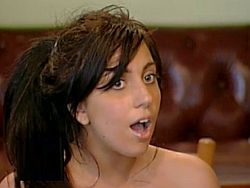
Photo of Stefani Germanotta prior to her “Lady Gaga” stardom.
 Gaga performing, 2009. |
|
Although she has developed her own singular style, artists said to have influenced her are dance-pop stars like Madonna and Michael Jackson and “glam rock” singers such as David Bowie and Freddie Mercury. Gaga has developed a penchant for controversial showmanship and sometimes over-the-top outfits. Yet, in the fashion world, she has become a welcomed player and something of an economic stimulus. With her rise to stardom she has appeared on the covers of numerous magazines, was named to Time magazine’s 100 most influential people in 2010, and is listed among the highest-earning celebrities by Forbes, taking in some $90 million in 2010.
Life, however, wasn’t always so kind to Stefani Germanotta. In high school, according to a Rolling Stone interview, Gaga was teased mercilessly. “Being teased for being ugly, having a big nose, being annoying,” she explained… “‘Your laugh is funny, you’re weird, why do you always sing, why are you so into theater, why do you do your make-up like that?’ . . . I used to be called a slut, be called this, be called that, I didn’t even want to go to school sometimes.” Gaga today, has become a champion to kids being bullied or shunned, and her music, with songs like “Born This Way,” helps some kids get through those tough times.
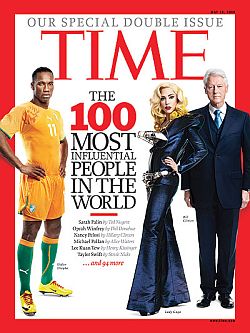
May 2010: Lady Gaga on the cover of “The Time 100” with Ivory Coast soccer star Didier Drogba and former U.S. President Bill Clinton. Click for copy.
In recent years, Lady Gaga has injected herself into the political arena, taking up issues such as, “don’t ask, don’t tell,” gay and lesbian rights generally, and teen bullying. In her political work on behalf of overturning the U.S. military’s “don’t ask, don’t tell” policy – which had prohibited gay and lesbian service members from serving openly because of their sexuality – she released three YouTube videos urging her fans to contact their Senators in an effort to overturn the policy. In September 2010, she also spoke at a Servicemembers Legal Defense Network rally in Portland, Maine.
Gaga has also contributed to the fight against HIV and AIDS. She teamed up with MAC Cosmetics to launch a line of lipstick under her Viva Glam Gaga line, the proceeds from which are donated to HIV and AIDS prevention worldwide – and according to Forbes magazine, $202 million so far from lipstick and lipgloss. Gaga has also become quite involved with her music business and related internet technologies.
_______________________________________
|
“Gaga @Google” 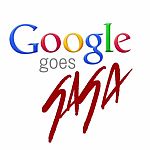 Lady Gaga visit at Google, headquarters, March 2011. 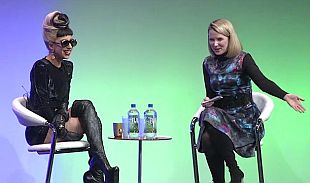 Lady Gaga at “Googleplex” session in Mountain View, CA, with Google V.P. Marissa Mayer, March 2011. Sitting with Mayer on stage, the pop star talked about a range of subjects including being bullied as a kid, her vocal training, dealing with the paparazzi, and being a woman working in the pop music business. She also mentioned the millions of fan and search hits she gets on Google, and the millions of views her videos get on YouTube. 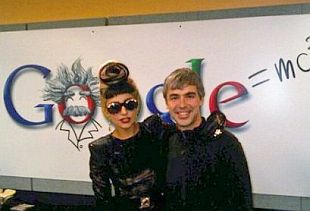 Lady Gaga with Google co-founder Larry Page, a photo she uploaded to the web the day of her visit in March 2011. At Google that day, Gaga also met briefly with Google co-founder Larry Page, whom she calls “Larry Google.” After her visit, she sent a Twitter message to her followers, also posting a photo of her and Page taken that day. “Just left Google,” she tweeted, “what a genius team.” Stay tuned; the Google-Gaga relationship may be just getting started. |
Entertainment Networks
Google’s advertising and networking, especially around entertainment superstars like Lady Gaga, also highlights a new kind of business and communications model that appears to be taking form, not only with possibilities at Google, but throughout the technology-entertainment community. Simple advertising campaigns, as the Gaga TV ad and others like it now show, can very quickly generate and build a connection to millions of fans – fans who are responsive to related messages and possibly much more.
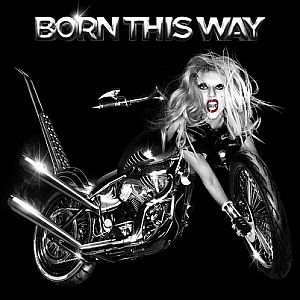
Lady Gaga’s “Born This Way” album helped set a digital sales record at Amazon.com, where fan response to a promotional special crashed the company's servers. Click for CD or digital.
Gaga and her managers have also been investigating other high-tech possibilities – and related business opportunities – for better ways to manage their powerful fan base. In 2010, after Apple began a music-based social network called Ping, Steve Jobs arranged for a meeting with Lady Gaga and her business manager, Troy Carter. Reports on that meeting, held at Apple headquarters in Cupertino, California, indicate that Lady Gaga quizzed Jobs about Ping’s design, and both she and Carter expressed concerns about the lack of Ping’s integration with other social networks like Facebook. Carter, in fact, came away thinking about a new kind of platform for entertainers that could help them manage their fan base across all major social networks. That idea has since become a new start-up company called Backplane, which will help to build platforms and communities of interests on the web around specific interests, such as those for musicians and sports teams – platforms that will work with Facebook, Twitter, and other such sites.
Carter, 38, has been Gaga’s manager for four years, and he knows first-hand how the internet has helped Gaga’s fan base grow. “There was a time when radio stations wouldn’t play Gaga’s music, because it was considered dance,” he explained in a June 2011 New York Times interview. “Outside of live performances, the internet became our primary tool to help people discover her music.” Carter’s new venture, meanwhile, Backplane, has raised more than $1 million from a group of investors led by Tomorrow Ventures, the investment firm of Google’s chairman, Eric E. Schmidt. Lady Gaga is also a major shareholder in Backplane with a 20 percent stake. Google, from its perch at the center of search and information technology, will have powerful new opportunities in social networking, advertising, film production, and entertainment. Observes Gary Briggs, a vice president at Google, who worked with Lady Gaga’s team on the Chrome TV commercial: “Troy and Gaga are doing things with communications and fan relationships that we haven’t really seen before.”
Google, meanwhile, has already begun to create special features with some of its web tools. In May 2011 it launched a music chart for videos called the YouTube 100 that charts song popularity in user-generated and professional music videos. Google is also building its own social networking site, known as “Google+,” which opened to the general public in late September 2011 and has surpassed 50 million users since then. Still, it has a ways to go to catch Facebook at 750 million users. However, Google has noticed that celebrities like Hollywood actor Ashton Kutcher helped Twitter reach stratospheric numbers of new members. After Kutcher’s high-profile usage and large number of followers made news — he soared to 1 million followers very quickly — Twitter received lots of press and new users. Google+ has already announced it will verify celebrity pages on its new site so celebrities will be confident of their identities, a policy that will also help to thwart the rise of imposter pages. Lady Gaga, and/or other high-profile luminaries may well be in line to help Google boost enrollment at its new Google+ site. Going forward, whether at Google or elsewhere, new kinds of celebrity and entertainment networks – and really quite valuable business hubs as well – will emerge as key economic winners.
In any case, the old media-entertainment complex is changing pretty dramatically these days, with internet technology increasingly paramount. And Google it seems, from its perch at the center of search and information technology, will have powerful new opportunities in advertising, social networking, film production, and entertainment.
Additional stories at this website on the history of media, celebrity, and advertising are listed at those category pages, with others found in the Archive or on the Home Page. Thanks for visiting — and if you like what you find here, please make a donation to help support the research and writing at this website. Thank you. — Jack Doyle.
|
Please Support Thank You |
____________________________________
Date Posted: 13 October 2011
Last Update: 17 February 2019
Comments to: jdoyle@pophistorydig.com
Article Citation:
Jack Doyle, “Google & Gaga, 2011,”
PopHistoryDig.com, October 13, 2011.
____________________________________
Sources, Links & Additional Information
 Lady Gaga throwing a kiss to fans, Google Chrome ad. |
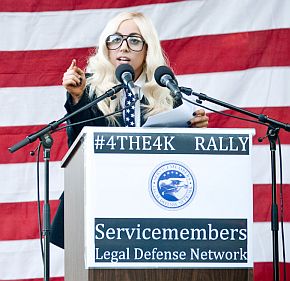 2010: Gaga speaking to repeal "Don't Ask, Don't Tell." |
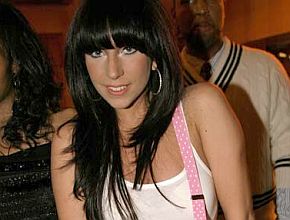 Stefani Germanotta, before her Lady Gaga days. |
Claire Cain Miller, “Google Takes to TV to Promote Browser,” New York Times, May 3, 2011.
Jared Newman, “Google Chrome TV Ads Tug at the Heartstrings,” PCWorld, May 4, 2011.
Emma Bazilian, “Google Kicks Off TV Campaign to Promote Chrome,” Ad Week.com, May 4, 2011.
Jennifer Bergen, “Google Chrome TV Ads May Bring a Tear to Your Eye,” Geek.com, May. 5, 2011.
Katharine Mieszkowski, The Bay Citizen, “At Google, The Book Tour Becomes Big Business,” New York Times, May 12, 2011.
GlamourZooombie, Google Chrome Ad, “Lady Gaga,” YouTube.com, May 21, 2011.
Jon Pareles, “Q. and A. With Lady Gaga on Her ‘Freedom Ride’,” New York Times, May 20, 2011.
Brian Stelter and Rachel Lee Harris, “Pop Stars Lift ‘SNL’ Ratings,” New York Times, May 22, 2011.
Amy Sciarretto, “‘The Web Is What You Make of It’ in Lady Gaga’s Google Chrome Commercial,” PopCrush.com, May 22, 2011.
“We’re Going a Bit Crazy for Lady Gaga in the Google Chrome Advert!,” Sugar Scape.com, May 29, 2011.
Grant McCracken, “Paws Up, Little Monsters,” HBRBlog (Harvard Business Review), Tuesday, May 31, 2011.
Jocelyn Vena, “Lady Gaga, Justin Bieber Pay Homage To Internet Roots In Google Chrome Ads,” MTV.com, June 30, 2011.
Jeffrey Van Camp, “Lady Gaga Stars in New Google Chrome Commercial,” Digital Trends.com.
Musicians@Google Presents: “Google Goes Gaga,” YouTube .com, March 2011.
Evelyn M. Rusli, “A Force Behind the Gaga Effect,” New York Times, June 6, 2011.
“The Edge of Glory,” Wikipedia.org.
Teressa Iezzi, “Meet the Google 5, the Team Behind ‘Parisian Love’ Super Bowl Spot,” AdAge.com, September 27, 2010.
“Google Goes Gaga: Lady Gaga Takes Questions on YouTube and Twitter and From Google Employees,” LATimes.com, March 23, 2011.
Michael Learmonth, “‘Dear Sophie’ Played on TV, but ‘Savage Love’ Won the Web for Google’s Chrome,” AdAge.com, May 12, 2011.
Google Chrome, “Dear Sophie,” You Tube.com, May 2, 2011.
Google Chrome, “It Gets Better,” You Tube.com, May 2, 2011.
“Dan Savage,” Wikipedia.org.
Google Chrome, “Justin Bieber,” You Tube.com, June 28, 2011.
“Lady Gaga,” Wikipedia.org.
Joe Thompson, “Gaga for Gaga – Watch Lady Gaga’s Google Chrome Commercial,” Gay.net, May 2011.
Chloe Albanesius, “Lady Gaga Stops By Google, Announces Directorial Debut,” PCMag.com, March 23, 2011.
“Troy Carter on Lady Gaga’s Brand Alliances”(video), AdAge.com, September 21, 2011.
“Lady Gaga Becomes First Twitter User with 10 Million Followers,” LATimes.com, May 16, 2011.
“Lady Gaga to Put Her Style, Music into Zynga’s Farmville Game with GagaVille,” LATimes.com, May 10, 2011.
Mark Milian”Google+ Has a ‘Celebrity Acquisition Plan’,” CNN.com, July 19, 2011.
“Lady Gaga’s Best Looks,” Photo Gallery (236 photos), Rolling Stone.com.
“Lady Gaga Discusses Her Struggles and Connection to Fans in Rolling Stone Cover Story,” Rolling Stone.com, May 25, 2011.
“Don’t Be Evil,” Wikipedia.org.
“Lady Gaga Fans Crash Website In Album Frenzy,” ContactMusic.com, May 24, 2011.
___________________________
